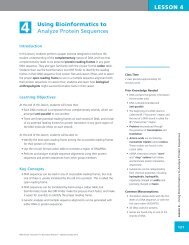WET LAB DNA Barcoding: From Samples to Sequences - Northwest ...
WET LAB DNA Barcoding: From Samples to Sequences - Northwest ...
WET LAB DNA Barcoding: From Samples to Sequences - Northwest ...
You also want an ePaper? Increase the reach of your titles
YUMPU automatically turns print PDFs into web optimized ePapers that Google loves.
<strong>WET</strong> <strong>LAB</strong><br />
CLASS SET<br />
11. Discard the flow-through from your no-cap collection tube and put your spin column back in the no-cap<br />
collection tube.<br />
12. Centrifuge your sample at 10,000 rpm for one minute <strong>to</strong> remove any residual Wash Buffer from the <strong>DNA</strong><br />
binding membrane in the spin column.<br />
[Note: If your centrifuge doesn’t go as fast as 10,000 rpm, centrifuge on maximum speed for 5 minutes.]<br />
13. Label a new 1.7 ml microfuge tube with your name, the date, and your sample name.<br />
14. Place your spin column in the labeled 1.7 ml microfuge tube from Step #13.<br />
15. Add 30 μl of nuclease-free water (labeled “Water”) <strong>to</strong> the membrane of your spin column, making sure not<br />
<strong>to</strong> <strong>to</strong>uch the membrane at the bot<strong>to</strong>m of the spin column with your pipette tip.<br />
16. Centrifuge your microfuge tube and spin column at 10,000 rpm for one minute.<br />
[Note: If your centrifuge doesn’t go as fast as 10,000 rpm, centrifuge on maximum speed for 5 minutes.]<br />
17. Discard your spin column.<br />
18. Close the lid of your 1.7 ml microfuge tube with your purified PCR sample and keep the tube on ice, or s<strong>to</strong>re it in<br />
the freezer, as instructed by your teacher.<br />
PART II: Preparing Your PCR Sample for <strong>DNA</strong> Sequencing<br />
The barcoding primers have been specifically designed <strong>to</strong> work with standard sequencing primers called M13F<br />
(M13 forward) and M13R (M13 reverse), which are provided free of charge by most <strong>DNA</strong> sequencing facilities.<br />
Many sequencing facilities require specific <strong>DNA</strong> concentrations, <strong>DNA</strong> sequencing tubes, and sequencing tube<br />
labeling. Check with your sequencing facility <strong>to</strong> see what they require.<br />
Determining <strong>DNA</strong> Concentration:<br />
Using Bioinformatics: Genetic Research<br />
Ideally, <strong>DNA</strong> concentration is determined using<br />
a spectropho<strong>to</strong>meter. If a spectropho<strong>to</strong>meter is<br />
available, ask your teacher for the correct pro<strong>to</strong>col. If a<br />
spectropho<strong>to</strong>meter is not available, you can estimate your<br />
<strong>DNA</strong> concentration using your molecular weight standard<br />
from your <strong>DNA</strong> gel in Lab 3. (See Figure 4.1).<br />
For example, we know from the product information<br />
provided with our molecular weight standard that the<br />
3rd band from the bot<strong>to</strong>m of the gel in Figure 4.1 is 750<br />
base pairs (bp) and contains 25 nanograms (ng) of <strong>DNA</strong>.<br />
To estimate the amount of <strong>DNA</strong> present in your PCR<br />
product, you should use the band closest in size <strong>to</strong><br />
your PCR product.<br />
For example, if a 700 bp PCR product is approximately<br />
four times as bright as the band at 750 bp in Figure 4.1,<br />
one can estimate that there is about 100 ng of <strong>DNA</strong><br />
in the PCR product band (4 x 25 ng = 100 ng).<br />
Figure 4.1: Molecular Weight Standard Used <strong>to</strong> Calculate<br />
Amount of <strong>DNA</strong> per Band.<br />
364<br />
©<strong>Northwest</strong> Association for Biomedical Research—Updated Oc<strong>to</strong>ber 2012
















